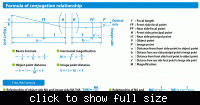Hi friends,
I have a set of lens extracted from various damaged Webcams.
Then I wish to get their optical parameters m ( magnification ) and f( focal distance ).
However, I dont´t know a procedure to do that.
Does anybody could sugest some ?
My first idea was to put a lens with known parameters as reference, but I can´t develop a closed formula.
Follows a model of ideal lens :
Geometrical :
Algebraical :
Thanks in advance.
+++
I have a set of lens extracted from various damaged Webcams.
Then I wish to get their optical parameters m ( magnification ) and f( focal distance ).
However, I dont´t know a procedure to do that.
Does anybody could sugest some ?
My first idea was to put a lens with known parameters as reference, but I can´t develop a closed formula.
Follows a model of ideal lens :
Geometrical :
Algebraical :
Thanks in advance.
+++
